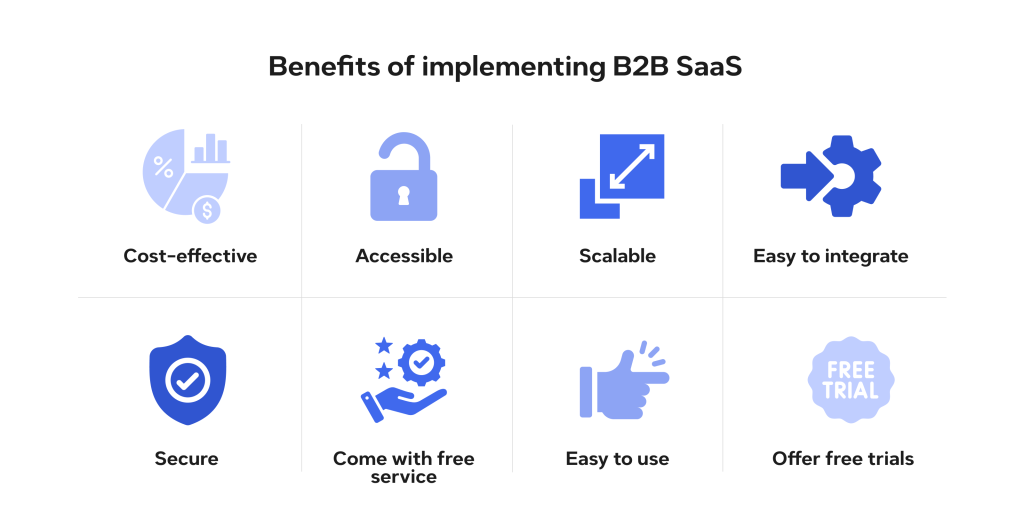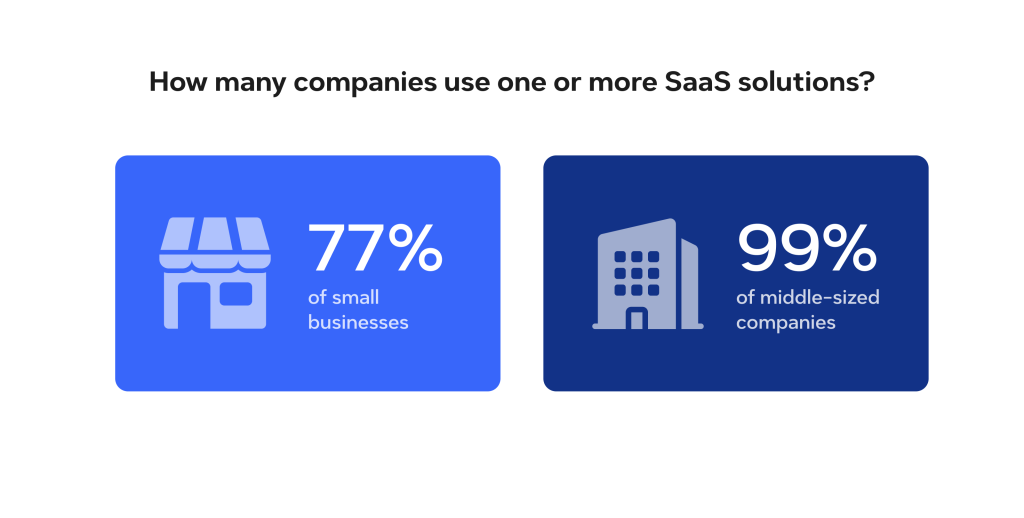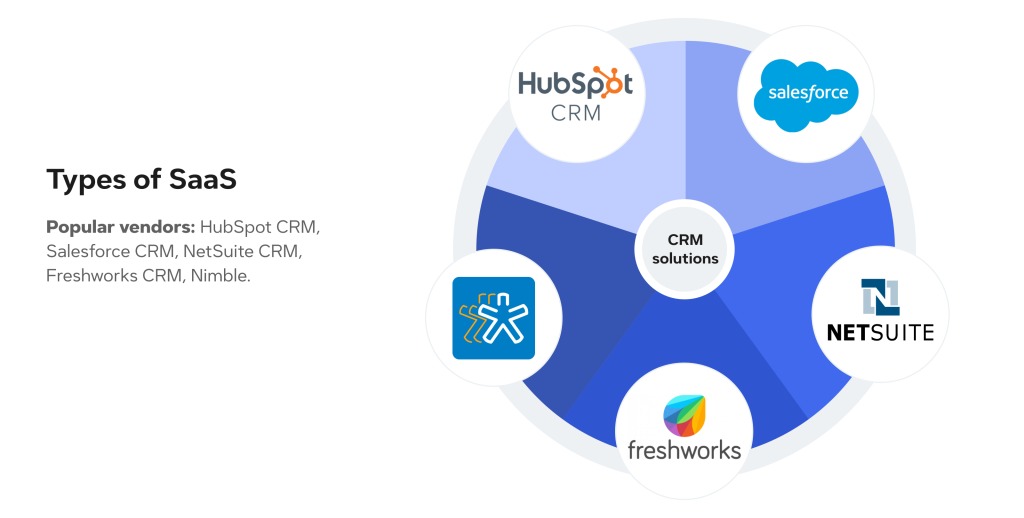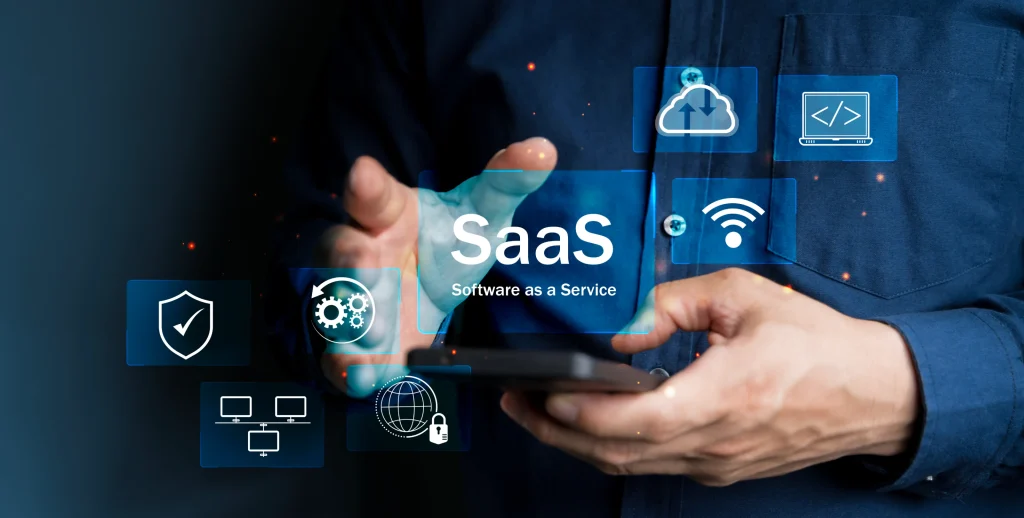We use cookies to ensure we give you the best experience on our website. By clicking Agree you accept our Privacy and Cookies Policy.
Types of SaaS solutions: categories and examples
Oleh Havrylyuk
Author

March 3, 2024
Date

 21 minutes read
21 minutes read
Content
As the world of software-as-a-service (SaaS) continues to evolve, it’s no surprise that industry trends and developments are changing rapidly. 2025 is set to be a big year for SaaS, with plenty of new innovations and improvements in store. In this article, we’ll take a look at some of the top SaaS trends expected to shape the industry in 2025—from new technology advances to market growth. We’ll also explore ways businesses can capitalize on these trends as they arise. So join us as we take a closer look into what’s coming down the pipeline in SaaS!
What is software as a service (SaaS)?
SaaS is web-based software accessible through the internet. Since SaaS adopts cloud computing technology, there’s no need for installing desktop applications — users simply subscribe to a service hosted on a remote server. For example, Netflix is a B2C SaaS platform that offers licensed videos on-demand and follows a subscription model.
SaaS (Software as a Service) is revolutionizing the way businesses operate today. It’s an innovative technology that allows companies to access software over the internet, eliminating the need for expensive and time-consuming installation, configuration and maintenance of servers and applications. SaaS makes it easier than ever for business owners to access the best software without all the hassle.
At its core, SaaS is based on cloud computing technology. By leveraging powerful data centers across the world, SaaS allows you to access software hosted in remote locations – meaning you don’t have to worry about managing your own server or updating your software. All that work is done by the service provider so you can focus on running your business instead.
SaaS also offers flexibility and scalability, allowing you to adjust your usage based on business needs. You’re only charged for the services you use – so if there’s a sudden spike in usage, you can quickly add more resources available without any additional hardware. This means that SaaS is perfect for businesses of all sizes – from start-ups to established enterprises.
The global SaaS market is expanding rapidly and will hit $436.9 billion in 2025. While COVID-19 is causing dramatic shifts in business due to telecommuting and social distancing, more companies rely on the SaaS model. Let’s take a closer look at the benefits of SaaS for business.

Benefits of B2B SaaS solutions
The SaaS model benefits software providers and their customers. For developers, SaaS allows a recurring revenue stream and faster deployment compared to traditional on-premise software. For companies, SaaS offers the chance to reach a wider audience and save software development and maintenance costs.


Ready to leverage the power of SaaS?
Contact us to discuss how we can help you build or implement the right SaaS solution.
Here are the top advantages of choosing SaaS for business:
- Cost-effective. A software vendor holds all maintenance and infrastructure costs.
- Accessible. SaaS products can be accessed from anywhere via a web browser.
- Scalable. Customers can change their usage plans anytime without hassle.
- Easy to integrate. SaaS solutions support multiple integrations with other platforms.
- Secure. The decentralized nature of cloud-based technology protects user data from breaches and loss.
- Come with free service. SaaS provides automated backups, free updates, and swift customer support.
- Easy to use. A friendly interface and simple user flow make SaaS easy to use for everyone, regardless of their technical skills.
- Offer free trials. Most SaaS vendors allow you to try it before you buy it.
The best part is that SaaS fits all industries and company sizes, so both large and small businesses can benefit from it equally. In the next chapter, we will explore different categories along with the most prominent examples of SaaS software. Check this link for an extended list of SaaS companies and solutions.

Types of SaaS solutions
When it comes to SaaS solutions, there are numerous types available. Let’s discuss some of them below.
Vertical SaaS
Vertical SaaS is a type of Software-as-a-Service (SaaS) solution that focuses on providing industry-specific software solutions. It is designed to help businesses within a specific vertical, such as financial services, automotive, healthcare and retail, by customizing their applications to meet their particular needs.
With Vertical SaaS, business owners can take advantage of advanced technology and sophisticated analytics without having to invest in costly hardware or IT staff. This makes it an ideal solution for small and medium sized businesses who want the same level of performance as larger companies but don’t have the resources or budget for traditional enterprise systems.
Horizontal SaaS
Horizontal SaaS is a type of software-as-a-service (SaaS) that offers a wide range of solutions to businesses across different industries. It provides a platform for companies to build and manage their products, services, and operations on the cloud, with the goal of streamlining their business processes and providing cost savings.
Horizontal SaaS is a type of software-as-a-service (SaaS) that offers a wide range of solutions to businesses across different industries. It provides a platform for companies to build and manage their products, services, and operations on the cloud, with the goal of streamlining their business processes and providing cost savings.
Batch SaaS
Batch SaaS is a powerful and efficient IT system that offers software as a service (SaaS) in bulk. It allows businesses to store, manage, and update large amounts of data with minimal effort. As an effective cloud-based solution, Batch SaaS can be accessed from anywhere at anytime.
The system is also highly secure. It utilizes cutting-edge encryption algorithms to protect data from unauthorized access, ensuring that confidential information remains safe at all times. Automatic backup systems are available as well, providing an extra layer of protection against data loss.
Hybrid SaaS
The hybrid type of Software as a Service (SaaS) is a cloud computing delivery model that combines on-premises applications and cloud-based services. It allows businesses to take advantage of the scalability, flexibility, and cost savings associated with cloud services while still having access to particular applications or data that reside on the physical premises.
Since the hybrid type of SaaS combines cloud and on-premises applications, it requires specialized technology. On-premises components are run in physical hardware that is usually stored in a data center or server room. Cloud-based services, meanwhile, are running in virtual machines hosted by public cloud providers such as Amazon Web Services (AWS), Microsoft Azure, and Google Cloud Platform.

The most common types of SaaS for business
As we mentioned earlier, the SaaS market is huge and highly segmented. The cloud service model has reached all business niches and generates billions of dollars in revenue for SaaS companies. For example, Salesforce — the world’s largest SaaS provider — made $17,1 billion in 2020 alone.
While the complete list of SaaS categories can be extensive, we will cover the most widely used ones.
CRM solutions
Customer Relationship Management software serves as a hub for customer-related operations. CRM systems help gather, categorize, and analyze customer data from various channels, including phone calls, social media, and website activity. By providing customer engagement tools such as loyalty campaigns and email marketing, CRM systems boost sales and foster conversation between a brand and clients.
Popular vendors: HubSpot CRM, Salesforce CRM, NetSuite CRM, Freshworks CRM, Nimble.
Accounting solutions
Accounting platforms assist accountants and bookkeepers in their daily tasks. Accounting software simplifies document flow by providing customizable templates. Moreover, it helps manage orders, revenue, billing, inventory, fixed assets, and taxes. Best solutions in this category provide data-based insights that improve the quality of financial decisions.
Calxa is a solution for financial management and forecasting developed by Blackthorn Vision. It integrates with popular accounting systems and automates budgeting workflows to generate simple, accurate analytics. Calxa is widely used by accountants, businesses, and non-profit organizations around the globe.
Popular vendors: Xero, MYOB AccountRight, QuickBooks Online.
Project management solutions
Project management apps implement tools for efficient project delivery. Using project management systems, you can break down projects into smaller tasks, define project milestones, assign tasks to team members, and set up project deadlines. Most PM solutions enable users to visualize data through Gantt charts, Kanban boards and generate productivity reports.
Popular vendors: Jira, Smartsheet, Trello, Asana.
HR solutions
Human resource management systems enhance and automate employee-related operations. HR systems take care of talent recruitment, candidate screening, hiring, performance evaluation, payroll management, time tracking, and more. They also offer statistical data and manage benefit programs for employees.
RemiPeople is a web-based HR management solution developed by the Blackthorn Vision’s team. It streamlines recruitment workflow by automating repetitive manual tasks and eliminating bias at every hiring process stage. Using RemiPeople, HR managers can select top candidates with less effort.
Popular vendors: BambooHR, Zoho People, Gusto, Workday HCM.
ERP solutions
Enterprise Resource Planning software automates document flow and work processes across departments. ERP systems provide absolute control in managing finances, manufacturing, inventory, billing, commerce, marketing, and other operations. Many ERP solutions integrate CRM, HR, project management, and accounting modules, covering all operational needs of a company.
Popular vendors: NetSuite ERP, Sage Intacct, Microsoft Dynamics 365, SAP ERP, Oracle ERP Cloud.
Web conferencing solutions
Web conferencing applications allow video and audio meetings through the internet. Many vendors offer advanced tools for collaboration such as file sharing, screen sharing, remote control, chat, and recording in addition to standard video and audio calls.
Popular vendors: Zoom, Cisco WebEx, Google Hangouts, Skype, GoToMeeting.
EHR solutions
Electronic health record software improves workflows throughout the healthcare delivery process. By storing all patient data in one place, these platforms provide instant access to lab results, radiographic images, clinical notes, patient charts, treatment history, and other clinical information to doctors and nurses. As a result, physicians get a complete picture of the patient’s condition to make a well-balanced clinical decision.
EHR software integrates with various medical applications to improve patient care and boost hospital staff efficiency.
Popular vendors: AirStrip One, Care360, Optum Physician EMR, RXNT.
E-commerce solutions
E-commerce platforms implement out-of-the-box features for online sales. With e-commerce solutions, anyone can set up their online store in just a few hours without the need to develop a website. These platforms allow adding and removing products, managing inventory, calculating taxes, integrating with payment systems, and creating blogs and marketing campaigns.
Many e-commerce vendors support design customization, so users can create a unique online presence that reflects their brand identity. The e-commerce category also includes SaaS marketplace software that allows building storefronts for multiple vendors.
Popular vendors: Shopify, X-Cart, BigCommerce, Wix, Salesforce Commerce Cloud.
Billing solutions
SaaS billing platforms include three categories: payment gateways, merchant accounts, and subscription management.
A payment gateway is a bridge between an online store and a bank that processes customers’ payments. Payment gateways offer secure and fast money transfers for buyers and sellers, support various payment methods, and protect user accounts from data breaches and fraud. Most payment gateways typically have merchant accounts as well.
Subscription management solutions enable businesses to charge their customers monthly, annually, or whichever billing model they choose. They offer various subscription pricing models and integrate with payment gateways and merchant accounts.
Popular vendors: PayPal, Stripe, BitPay, Amazon Payments, 2Checkout, Recurly.
Collaboration and file sharing solutions
This category includes different solutions, from simple cloud-based file storages to all-inclusive workspaces for internal corporate collaboration. Collaboration platforms typically provide communication and file exchange tools that bring together members from remote and decentralized teams. Some platforms resemble social networks like Facebook with corporate groups, pages, events, and home feed.
Popular vendors: Yammer, Slack, Dropbox, Atlassian Confluence, OneDrive.

Different types of cloud services for different business goals
Cloud as a service is in high demand for small enterprises to global billion-dollar corporations. However, cloud services grasp more than just SaaS technology. When thinking about moving business operations online, it’s important to know what options you have.
Each cloud model provides specific features that can be leveraged for particular business needs:
- SaaS is suitable for small companies that are looking for solutions with rapid time-to-market and low costs. It’s also beneficial for short-term projects and companies that need simple and affordable software for managing their inner processes
- PaaS is the right fit for software development projects, especially the ones with multiple development workflows. Since PaaS is extremely flexible and adaptable to customization, developers can integrate with third-party vendors with ease.
- IaaS will benefit companies that prefer to control their infrastructure and avoid extra costs. For fast-growing companies that often change their hardware and software requirements, IaaS offers ample flexibility and scalability.
Whichever option you choose, the fact that cloud computing services are the future of business is beyond dispute.


Contact us to build your SaaS project
Start with a question to engage the reader, state the value proposition clearly, and then use a direct call to action
SaaS business and architectural models
Beyond a functional classification, the true nature of a SaaS solution is defined by its architectural and business strategy.
Vertical vs. Horizontal SaaS
Horizontal SaaS applications (e.g., Slack, Salesforce) are designed to serve a broad range of industries by addressing a common business need. Vertical SaaS, conversely, is purpose-built to meet the unique requirements of a single industry, such as a solution for healthcare or finance, often offering deeper integration and specialized features.
Single-Tenant vs. Multi-Tenant architecture
The core of a SaaS solution’s scalability and cost-efficiency lies in its architecture. A multi-tenant model is the most common, where a single instance of the software and its underlying infrastructure serve multiple customers. This approach is highly efficient but requires robust data isolation. In contrast, a single-tenant architecture provides a dedicated software instance and environment for each customer, offering maximum data security and customization at a higher operational cost.
Monetization models and their technical implications
The choice of a monetization model is a critical business decision that directly impacts the technical design of a SaaS platform.
- Per-user pricing. This straightforward model bills based on the number of users. It requires a robust user management and licensing system to track and enforce access.
- Tiered pricing. Offering multiple subscription levels with varying feature sets and limits demands flexible “feature flag” systems that can toggle functionalities for different customer tiers.
- Usage-based pricing. This complex model bills customers based on their consumption of a specific metric (e.g., API calls, data storage). Implementing this requires a sophisticated and granular metering system to accurately track and report usage in real time.
Successful SaaS businesses monitor a set of key metrics that go beyond simple sales figures. Metrics like Monthly Recurring Revenue (MRR), Customer Lifetime Value (LTV), and Customer Churn Rate (CCR) are essential for measuring product health and forecasting growth.
SaaS in the broader cloud ecosystem
Modern SaaS is rarely an isolated application. It is deeply integrated into the broader cloud technology landscape.
- Microservices architecture. Many contemporary SaaS solutions are built on a microservices architecture. This allows individual components of the application to be developed, deployed, and scaled independently, ensuring agility and resilience.
- Leveraging PaaS and Serverless. SaaS developers increasingly rely on Platform as a Service (PaaS) and serverless computing models. Services like managed databases and serverless functions (e.g., AWS Lambda) accelerate development, reduce operational overhead, and enable automatic, on-demand scaling without manual server management.
Why has SaaS become so popular?
Software-as-a-Service (SaaS) has become increasingly popular due to its cost effectiveness and ease of use.
Unlike traditional on-premise software solutions, SaaS offers businesses the ability to access their applications without investing in costly hardware or IT infrastructure. By utilizing cloud computing technology, SaaS providers can host their applications on their own servers, allowing customers to access them without needing their own infrastructure.
Additionally, SaaS applications are typically easy to set up and use with minimal training required. This makes them a great choice for businesses that need software but don’t have the resources or IT know-how to support traditional applications.
Furthermore, SaaS applications can be accessed from anywhere and on any device, making them extremely convenient for both users and businesses alike. Finally, thanks to its pay-as-you-go model, SaaS offers a cost-effective solution for businesses of all sizes. All of these reasons make SaaS an attractive option for many companies looking for innovative software solutions that are easy to use and cost-effective.
Top 8 SaaS trends
In the world of Software-as-a-Service (SaaS), 2025 promises to be a year full of opportunity and innovation. As businesses continue to move away from traditional enterprise software solutions, SaaS companies have been quick to ride the wave of digital transformation. This year will bring several trends that are sure to shape the future of SaaS, from cloud-native integrations to multi-cloud architectures.
AI & Machine Learning
In 2025, AI and machine learning will continue to be integral components for SaaS businesses. The prevalence of AI-powered automation will increase significantly as companies strive to save time and money by using automated processes that can execute tasks quickly and accurately. Additionally, advanced analytics tools will provide actionable insights into customer behavior and production efficiency.
This data-driven approach will enable SaaS companies to continuously optimize their operations and maximize customer satisfaction. Furthermore, tools such as natural language processing (NLP) and computer vision technology will allow for more personalized interactions between software and customers. As a result, AI-driven solutions will be crucial for helping SaaS businesses stay competitive in the market.
Therefore, it is essential that SaaS companies continue to invest in AI and machine learning technologies as they are sure to provide a significant return on investment.
Mobile-first development
The emergence of mobile-first development in SaaS is expected to continue to grow over the next few years. By 2025, mobile-first development will be a major focus for software as a service (SaaS) providers, as more and more users adopt smartphones and tablets. Mobile-first development means that developers are building applications for mobile platforms first and then porting them to desktops, or vice-versa. This is in contrast to traditional development practices which have typically focused on desktop applications first.
The growth of mobile-first development will bring a number of benefits for SaaS providers, as it allows them to build applications that can reach a larger user base. It also means that SaaS providers can roll out new features and updates faster than ever before, as mobile platforms are constantly evolving with the introduction of new technologies. Additionally, mobile-first development allows for greater flexibility in terms of user experience and UI design, allowing for better user experiences across different devices.
Low-code and no-code solutions
As the Software-as-a-Service (SaaS) sector continues to expand, the demand for low-code and no-code solutions is also increasing. Low-code platforms make it easy for non-programmers to build complex applications quickly and efficiently. No-code platforms allow users to create applications with zero programming skills. By 2025, it is estimated that low-code and no-code platforms will become more widespread in the SaaS sector.
This will allow businesses to create applications faster with fewer resources, freeing up developers to focus on innovation instead of tedious tasks. Low-Code and No-Code solutions also help reduce development costs, as they require less engineering time, and they can be quickly adapted to changing business needs.
Additionally, low-code and no-code platforms are more easily understood by non-technical users, making them easier to use and requiring less training. This allows organizations to get up and running with their applications faster than ever before.
Micro SaaS products
In 2025, micro SaaS products are expected to be the go-to solutions for businesses looking to streamline their processes. With the rise of new technologies such as artificial intelligence and machine learning, these micro SaaS products can help automate mundane tasks, freeing up resources for more productive pursuits. Furthermore, since these solutions are often low-cost and require little effort to implement, they can deliver rapid returns on investment.
For example, a small business that wants to improve its customer experience may choose an AI-powered micro SaaS product to automate customer support tasks. This solution would monitor incoming messages for common queries and provide instant responses. It could even track customer service history to provide personalized feedback. The results: improved customer satisfaction and reduced labor costs.
Migration to PaaS
Migration to PaaS (Platform as a Service) is expected to be one of the major trends in SaaS in 2025. This trend has been growing over the past few years, and it’s likely to accelerate significantly in 2025 as companies look for ways to lower costs and increase scalability.
PaaS solutions provide users with a platform for developing and deploying applications over the Internet, without having to manage the underlying infrastructure. This can reduce costs significantly and make it easier for companies to rapidly scale their solutions as needed.
The trend towards cloud-based platforms such as PaaS also has been growing in popularity due to its ability to provide users with instant access to a wide range of services. By utilizing the cloud, businesses can increase their agility by reducing IT overhead and allowing teams to quickly develop new solutions or scale existing ones.
Enhanced cybersecurity & data privacy
The increased sophistication of cyber attackers and the prevalence of data-driven business models have made cybersecurity and data privacy essential for success in the digital era. As more companies move to SaaS-based systems, enhanced cybersecurity and data privacy will be a critical trend in 2025. To address this issue, businesses must consider investing in advanced security strategies such as biometric authentication, two-factor authentication, encryption, and access control.
Businesses must also ensure that their data privacy policies are comprehensive and up to date with the latest regulations. Implementing these measures will help protect companies from malicious actors and provide peace of mind for those dealing with sensitive information. In an increasingly connected world, advanced cybersecurity and data privacy will be essential for companies to successfully leverage SaaS technology.
Vertical SaaS
Vertical SaaS is a 2025 trend in the software as a service (SaaS) industry that involves creating and selling applications specifically designed for a single industry or sector. This model of software delivery allows businesses to purchase tailored solutions that are custom-built for their specific needs, rather than having to rely on generic, one-size-fits-all solutions. Vertical SaaS focuses on highly specialized industries, such as healthcare and finance, allowing for faster deployments of new features and more efficient customer service.
This type of software is often cloud-based, making it easier to scale up or down depending on the needs of individual customers. It also allows businesses to get access to specialized features or integrations that would otherwise be unavailable. As businesses continue to look for ways to optimize operations and increase customer satisfaction, vertical SaaS is becoming an increasingly attractive option in the SaaS industry.
SaaS connections and Integrations
The proliferation of SaaS applications in the market has been met with a growing demand for more seamless integrations between these services. SaaS connections and integrations are set to be one of the key trends of 2025, as businesses look to optimize their digital workflows.
This trend will enable organizations to link together different systems, such as customer relationship management (CRM) and analytics, to create an integrated platform for all their data needs. This not only helps streamline operations but also provides a more comprehensive view of the organization’s performance, allowing them to make better decisions.
Additionally, SaaS connections and integrations can provide businesses with enhanced security features due to the increased data protection and visibility that they offer. This trend will be particularly attractive to organizations dealing with confidential or sensitive customer information.
The bottom line
Thanks to powerful tools available through the cloud, more businesses can enhance their operations and increase profit with SaaS, PaaS, and IaaS. Whether companies need to store their software, maintain and secure their infrastructure, or effectively manage their teams, cloud computing solutions remove barriers to meeting business goals.
Blackthorn Vision has been building smart scalable SaaS solutions for startups, small, medium, and large enterprises since 2009. Our vast experience in SaaS development grasps multi-tenant applications, microservices, API integrations, and end-to-end DevOps. From implementing software architecture to designing mobile-friendly SaaS applications, we help companies establish recurrent revenue streams.




























































